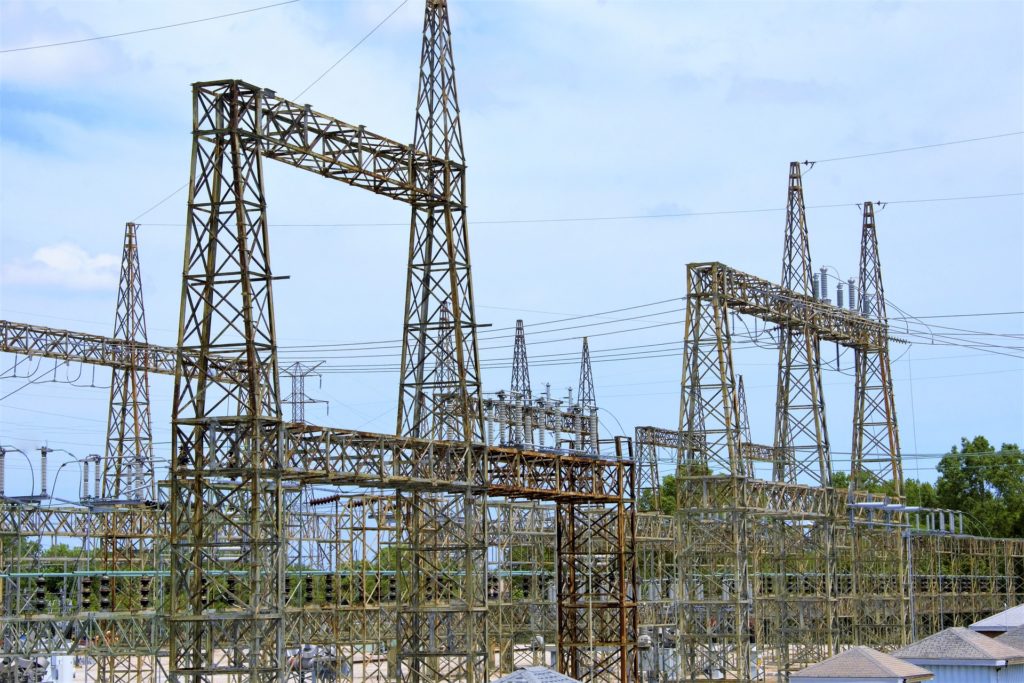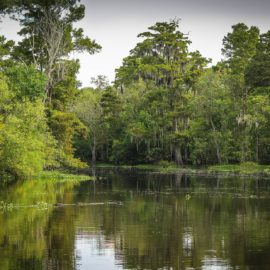
Above ground electrical wires as cheaper to run but open to more damage. Hurricanes cause damage and we still see bent poles around neighborhoods. Florida went through this as they get more hurricanes and what they did could work for us.
Two consecutive hurricane seasons brought hellish storms that battered the electrical grid and left millions languishing in the summer heat, waiting for the power to come back on. A chorus of voices called for major investments in the grid to prevent a recurrence. Sound familiar? That was the scene in Florida in 2004 and 2005. The Florida hurricanes of the early aughts — eerily similar in strength and timing to those that thrashed Louisiana in 2020 and 2021 — resulted in reforms to the Sunshine State’s utility regulations and massive infrastructure investments. The local, state and federal governments and Florida’s power companies spent billions upgrading above-ground structures, burying power lines and investing in “smart grid” technology. According to regulators and some consumer advocates, the effort made a huge difference. Florida’s improved grid may be able to serve as a roadmap of sorts for Louisiana, where a similar onslaught of hurricanes in 2020 and 2021 has prompted cries for massive investment.
nola.com
These changes as hurricanes will still cause damage but the magnitude is less.
While hopeful in some ways, Florida’s experience also illustrates the limits of grid-hardening under the current system of investor-owned utilities, which recoup their costs from ratepayers. Recent hurricanes have still knocked out power to millions of Floridians, though the lights come back on faster now. As would likely be the case in Louisiana, Florida ratepayers are the ones footing the bill for the investments. An unprecedented four hurricanes hammered Florida over a six-week period in 2004, punctuated by Category 4 Hurricane Jeanne. The next year, there were four more. Collectively, the storms caused 15.5 million customer power outages — meaning the average Floridian lost power more than once — and calls for a more resilient electrical grid followed. Regulators pushed power companies to make a slew of changes. The Florida Public Service Commission required regular inspections of wooden poles, 10-year grid hardening plans and annual hurricane preparedness briefings. Utilities were also ordered to regularly inspect transmission lines and substations, and to replace or upgrade those that failed. The state also made a push to bury more power lines after roping in universities to study grid hardening. Before the onslaught of storms, burying lines had been difficult to justify because it’s expensive and the cost falls on utility customers. The state started requiring utilities to compare the cost of burying lines with installing “hardened” above-ground lines, and by making power companies consider the long-term benefits of having the lines safe from high winds. Plus, it allowed the costs of burying lines to be spread among all ratepayers if there are “quantifiable benefits” to everyone. The state also invested in “smart grid” technologies that gather and analyze data from around the power system, leading to better maintenance and allowing utilities to recognize outages quicker, according to regulatory documents and interviews.
The main thing Florida did was to bring all involved together so a joint session would have all voices.
One of the most important things Florida did, according to Ted Kury, who heads an energy research center at the University of Florida, was to bring academics, power companies, regulators, consumer advocates and other stakeholders together to tackle storm resilience. Nothing like that has ever been attempted in Louisiana. Every year, the FPSC hosted workshops where power companies were asked “what your plans are for the future and how we are going to make sure that it’s in the best interest of the people who are paying the bills,” Kury said. While burying power lines and installing concrete poles have a steep price tag, Kury noted that there is also a cost of inaction: When hurricanes wreak havoc on the grid, ratepayers are on the hook for repairs. There are also the indirect costs of the outage itself, which can be considerable. “No matter what your decision is — whether you’re going to improve the resilience of the grid or not — the people are ultimately paying the cost of that decision,” he said.
We are already paying more for Ida and if I had to pay a bit more to ultimately pay less I would do that.
Florida’s method, though costly, has shown results. In 2018, the FPSC issued a report concluding “Florida’s aggressive storm hardening programs are working.” The length of outages was “reduced markedly” from the 2004-2005 storm season, “very few” failures of transmission facilities were reported, and underground lines performed “much better” than overhead lines. The improved system is not impregnable. In recent years, hurricanes have continued to cause mass outages: Irma knocked out power to nearly two-thirds of Florida customers in 2017. In 2018, outages endured for more than a week in parts of the Florida Panhandle after Michael hit. Partly in response to those storms, lawmakers took a fresh look at grid-hardening in 2019, passing a bill that would set up a separate regulatory track for funding burying power lines. Opponents of the new law warned it could lead to higher rates. JR Kelly served as Florida’s public counsel from 2007 until January of this year, an appointed position in which he advocated for consumers in often-dense FPSC meetings. Kelly cautioned the new bill gives power companies license to charge ratepayers more, and said he would advise states like Louisiana to keep storm hardening as part of the normal rate-making process. He also pointed to bolstered tree management and newly required pole inspections as key parts of the endeavor. Kelly said the grid is more resilient now, but noted it can be difficult to measure exactly how much more — and that customers ultimately pay for the investments. “I think whatever you authorize, make sure you put proper checks and balances for accountability in place,” Kelly said.
Despite the pay questions, the changes do seem to have worked.
It’s clear that the changes made over the years have lessened the length of outages in some recent storms. After Hurricane Irma in 2017, it took just one day to restore power to half the affected customers, according to a 2020 report by an IEEE Power & Energy Society task force. By way of comparison, it took five days to restore power to half of customers after Wilma, a less-powerful storm that struck in 2005. But there are caveats for Louisianans looking to the Sunshine State for guidance. The big one is the cost. Rates for customers of Florida’s five investor-owned utilities shot up from an average of $102 a month in 2006 to $119 a month for someone who used 1000 kilowatt hours in 2009, according to Florida PSC figures. Rates have fluctuated in the years since and were at $114 a month in 2020, though it’s difficult to say how much is attributable to storm-hardening. Bradley Marshall, an attorney representing the environmental group EarthJustice, also pointed out the “base rates” — which exclude things like fuel costs — have more than doubled for customers of Florida Power and Light, the state’s largest utility, from 2006 until now. Marshall said the increasing base rates leave “very little wiggle room” for when fuel prices shoot up. While FPL’s rates are actually lower now than in 2006, that’s slated to change soon when rates go up, to about $15 a month higher than they were back then. “Florida’s grid has become very reliable,” Marshall said. “Obviously there’s a tradeoff between reliability and costs and rates. Rates have gone up and continue to go up substantially.”
With more renewable the fuel costs may recede but you still have to transmit the power to the homes. Also, we are not Florida in a number of ways so what works there might not do so here.
And unlike Louisiana, Florida has seen a significant increase in population over the last decade: Its growth of nearly more than 14% works out to nearly 3 million new residents, which means there are more potential ratepayers to share the cost of infrastructure investments. The increase in population alone is about two-thirds as many people as live in Louisiana. Floridians’ incomes are higher on average than in Louisiana, making it easier for power companies to charge ratepayers for grid investments. Some cities have moved to bury all their overhead lines. Winter Park, a city of about 31,000, and the small, wealthy enclave of Palm Beach are both in the process of doing so. Palm Beach is covering the cost with a 30-year property tax, according to the Palm Beach Daily News.
Even with what looks like a mundane problem as all need power so all should agree there are problems.
Still, the debate over how aggressively to bolster the grid in Florida remains contentious. Robert “Schef” Wright, an attorney who represents customers and local governments before the Florida PSC, said he tangled for years with power companies who were reluctant to bury distribution lines — the low-voltage overhead lines typically seen in neighborhoods. The 2004-2005 hurricane season changed that. “We have had significant beef with some of the utilities regarding what they want to charge us to put our power lines underground,” Wright said. “That situation is improving across the board,” he added, a development he attributes to power companies and residents starting to see the benefits. The money spent by utilities has also drawn criticism for helping rich neighborhoods first, while burdening all ratepayers with higher bills. Marshall, of EarthJustice, said burying lines is expensive, and that utilities tend to target wealthier neighborhoods first, even though the costs may be spread more broadly. He cautioned against giving power companies a “blank check.”
Entergy Louisiana has commented on these ideas.
Phillip May, President and CEO of Entergy Louisiana, pointed to the high costs of burying power lines, but said in an interview that the power company agrees lines should be buried in some instances. May said Entergy is looking at what Florida has done, but noted some things, like putting up concrete poles, are more difficult in coastal Louisiana. Entergy spokesperson David Freese added the company has chosen wooden poles that are as windproof as concrete poles because it’s easier to find crews to work on them, making restoration quicker after a storm. “We’ve proven we can build robust structures,” May said. “Mother Nature will likely find a way to challenge whatever we build… What we have to have is a plan A, a plan B, a plan C. We have to have alternatives and redundancies built into the system.” While Entergy says it’s continually replacing older poles with newer ones, the company wouldn’t provide a breakdown of how its newer structures fared versus older ones during Ida. Lawmakers requested similar data in a September hearing; another hearing is expected in the coming months. Experts say the ticket to a resilient grid is a combination of putting lines underground where feasible, along with erecting stronger above-ground poles that won’t topple over when high winds come. “It’s very much a decision that’s best made at the local level, taking into account the local threats,” said Kury, of the University of Florida. “Ultimately, the people pay for everything. There really is no way to get around that.”
This is something Entergy needs to look at and the the public should be involved. I am sure there are departments at both Tulane, UNO and LSU that would love to get involved in thoughts and implementation plans. We should start now as the hurricanes are not stopping and will be getting worse.



